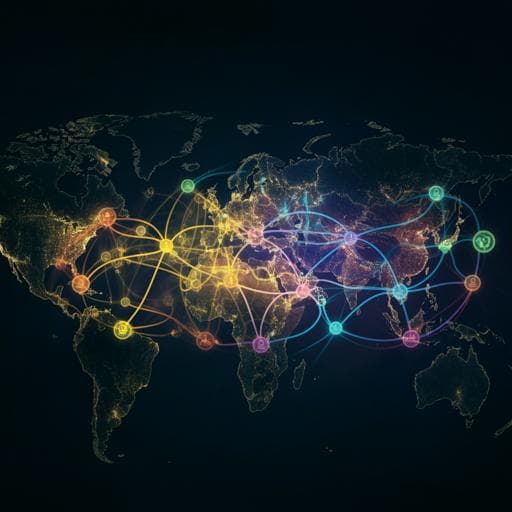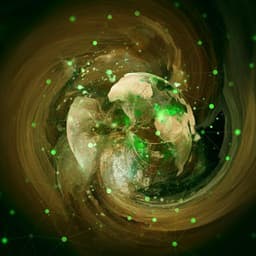
Environmental Studies and Forestry
Global environmental impacts of food system from regional shock: Russia-Ukraine war as an example
H. Zhang, L. Jiao, et al.
Discover how the Russia-Ukraine conflict has led to global food shortages and its environmental implications, as researched by Haoran Zhang and colleagues. This groundbreaking study reveals a decrease in cropland use and greenhouse gas emissions, with innovative strategies to optimize food supply networks in high-efficiency countries.
~3 min • Beginner • English
Introduction
The study addresses how short-term external shocks—exemplified by the Russia-Ukraine war—affect global food security and environmental sustainability. Despite SDG2’s goal of zero hunger, 2.3 billion people face food insecurity, and the food system contributes about one-third of global GHGs and substantial habitat loss. The conflict disrupts major exporters (Russia and Ukraine account for a significant share of global grain and oilseed trade) and fertilizer supplies, triggering export bans and trade restrictions. The research question is how such a regional shock propagates through global food production and trade to create food shortages and environmental pressures, and how to optimally restructure production and trade to balance food supply with mitigation of cropland use and GHG emissions. The authors propose and apply a shock–impact–response framework to quantify production/trade disruptions, assess embodied cropland and GHG impacts, and optimize post-shock supply networks.
Literature Review
The paper situates its contribution within several strands: (1) Global food system impacts and sustainability challenges (e.g., food systems contribute ~1/3 anthropogenic GHGs; habitat loss). (2) Extensive work on long-term shocks such as climate change vs. limited quantification and alleviation strategies for short-term shocks (wars, extreme events, pandemics). (3) Specific analyses of the Russia-Ukraine conflict indicating high dependence of many countries on Russian/Ukrainian exports (wheat, barley, rye, sunflower, oils) and fertilizer markets, with export restrictions exacerbating insecurity. (4) Proposed responses in literature include ending the war, diet restructuring (EAT-Lancet adoption), expanding production, and transforming trade/food systems. However, prior work lacks quantification of environmental impacts from compensatory production/trade and guidance on balancing food supply with cropland and GHG mitigation. This study addresses that gap.
Methodology
The authors develop a three-step shock–impact–response framework:
- Shock-impact simulation of production/trade: An Adaptive Multi-Regional Input-Output (AMRIO) model captures short-term disequilibria and interdependencies across regions/sectors in weekly steps. It includes modules for production (Leontief), capital limitation, supply constraints, intermediate inputs via inventories, labor supply shocks, and demand. The Russia-Ukraine conflict is parameterized via four scenario levers: duration (12 vs. 24 months), severity of damage in Ukraine (20% vs. 40%), Russian export sanctions intensity (20% vs. 80%), and countries involved (unfriendly list vs. all). Four scenarios are analyzed (short/long term × low/high intensity).
- Embodied environmental accounting: A Quasi Input-Output (QIO) model tracks direct and indirect trade in nine crops (rice, wheat, maize, barley, rye, beans, rapeseed, soybeans, sunflower seed). It constructs trade matrix T, computes direct outflow coefficients B and the total outflow G = (I − B)−1, and links production to consumption via H = G diag(c) diag(x)−1. Cropland use (L) is derived from production divided by yield; production-based GHG emissions (E) cover agricultural energy and process emissions using region- and crop-specific factors (IPCC and prior studies). Unit yields under war are corrected using NDVI (Mar–Oct 2022 vs. prior years). Production-based and consumption-based embodied flows are obtained: L^T = diag(L/P)×(T+C), E^T analogously; and transfers via L^H = diag(L/P)×G×diag(C), E^H analogously.
- Multi-objective optimization of recovery: Using NSGA-II (pymoo; population 100; 500 iterations; elitist sorting, crowding distance; constraint handling), the model optimizes post-shock global production (P) and trade (T) to minimize: (i) transport fuel costs (rail/ship), (ii) production-based GHG emissions, and (iii) cropland use. Constraints: material balance f(P)+f(Im)+f(S)=f(C)+f(Ex); f(P)≥f(Ex); 0≤f(P)≤f(Ps), 0≤f(T)≤f(Ts) with Ps and Ts capped at 1.5× pre-conflict; Russia/Ukraine production and exports constrained ≤ prewar values. Decision-making selects global optima from the Pareto set using pseudo-weights and augmented scalarization (compromise programming).
Key Findings
- Production and trade impacts: For the nine crops, global production declines by 0.6–1.8%; exports drop 3.5–7.2%; imports drop 4.3–9.3%, with import reductions mainly in Asia and Europe. Rapeseed and soybeans are most affected (>2% yield reduction). In the next season, production recovers by 2.4–3.0% relative to the first war year but remains below prewar; exports recover by ~50% relative to last year yet stay ~4% below prewar; imports still decline 0.8–5.7% (over 75% of declines in Asia).
- Food shortages and at-risk populations: Global shortage totals 53–130 Mt during the conflict; regional shares: Asia ~80%, Africa ~10%, Europe ~7%. Countries with worst per capita shortages (>50 kg/person) include Djibouti, Israel, UAE, Oman. Wheat and rice dominate shortages. An estimated 360–490 million people face nutrition security risks across the nine crops. With seeding resumption, shortages fall by 62–73%, yet residual shortages of 1.4–4.9 Mt persist; Northeast Africa and the Middle East still see ~25 kg per capita deficits (Africa/Americas: wheat; Asia: soybeans; Europe: maize; Oceania: rice).
- Short-term environmental effects: War-induced disruptions cause 3–11 Mha cropland abandonment (0.3–1% of global cropland), notably in the east coast of South America, SE Asia, and Oceania; concurrent expansion needs of 59–68 Mha arise in Asia, Africa, and Europe due to lower yields (fertilizer shortages). Short-term GHG emissions decline by ~24–60 Mt CO2 (0.6–1.4% of agricultural total), with reductions from the Americas, Asia, and Oceania (notably rice in Africa/Asia; soybeans in the Americas; barley in Oceania). Countries less affected sustain production, adding ~19–20 Mt CO2.
- Long-term recovery impacts: Recovery triggers 9–10% global cropland expansion and 2–4% GHG increases; 88% of countries see GHG rises totaling ~55–76 Mt CO2; ~92–103 Mha cropland demand (≈ prewar cropland of Brazil). Increases concentrate in East Asia, Eastern Europe, and the east coast of the Americas; crops: wheat, rice (GHG), and maize, wheat, rice (land).
- Embodied trade pattern shifts: Embodied cropland flows shift more toward Asia overall, but transfers to Asia from other continents decline compared to prewar, while flows to the Americas intensify. Net outflows to Asia increase by 23–59 Mha; net outflows from Europe to others rise by 27–52 Mha. Largest cropland transfer reductions: Myanmar/Thailand/Argentina to China; increases from Mongolia/Canada to China. Embodied GHG net transfers from the Americas/Oceania to others decrease; from Africa/Europe increase (Europe +10–32 Mt CO2 to others). Largest GHG transfer decreases: Argentina/USA to China; increases: Uruguay/Mongolia to China.
- Optimized supply networks: Multi-objective optimization reduces GHG by 1.7–2.7% (≈34–49 Mt CO2) and cropland by 3.7–4.5% (≈37–61 Mha) relative to war scenarios, with transport costs held constant; benefits increase if production further recovers. Suggested crop-specific reallocations include: France +47% barley; beans: reduce India −15%, increase Brazil/Myanmar; maize: USA +39%; rapeseed/rice/wheat: reduce India, increase China; rye: reduce Poland, increase Germany/Denmark/Belarus; soybeans: USA +18%, Argentina −43%; sunflower seed: shift to Argentina/Romania and others; staples (wheat/rice) mainly supplied by Asia (China/India), maize by the Americas.
Discussion
Findings demonstrate that a regional war shock propagates through global production and trade to create substantial short-term shortages and temporary declines in cropland use and GHG emissions, followed by land- and emission-intensive recovery. The results highlight the vulnerability of trade-dependent regions (Asia, Africa) and the tele-connected environmental burdens shifting toward China and Europe during recovery. Policy implications include: removing trade barriers and maintaining diversified, barrier-free trade to reduce shortages and environmental spillovers; leveraging comparative advantages to produce in higher-efficiency, lower-emission locations; and adopting complementary demand-side actions (diet shifts toward plant-based patterns, reducing waste, and food conservation) to alleviate pressure. Protection of biodiversity hotspots is critical during expansion, especially in low- and middle-income countries identified at higher risk; improvements in yields via climate-resilient technologies and circular food systems can mitigate land expansion. The optimization results show that strategically reshaping production/trade can offset a substantial share of postwar environmental increases while maintaining supply, but trade-offs among transport costs, GHG, and land require balanced, multi-objective decision-making.
Conclusion
The study introduces a shock–impact–response framework that integrates AMRIO-based disruption modeling, QIO-based embodied environmental accounting, and multi-objective optimization to evaluate and improve global food system resilience under short-term shocks. Using the Russia-Ukraine war as a case, the authors show: immediate production/trade contractions, large food shortages (53–130 Mt) and populations at risk (360–490 million), temporary cropland abandonment and GHG declines, and, with recovery, substantial increases in cropland use (9–10%) and GHG emissions (2–4%). Optimized reallocations of production and trade can reduce GHG by 1.7–2.7% and cropland by 3.7–4.5% relative to war scenarios, offsetting 45–89% of postwar environmental increments while keeping transport costs manageable. Future research should extend to longer-term system evolution, incorporate improved calibration as data become available, and consider region-specific potentials for environmental performance improvements in agriculture.
Limitations
The authors note: (1) The analysis focuses on current conditions and the near-term future; longer-term impacts on the food system are not explored. (2) Due to data lags, simulated outcomes could not be fully calibrated against real-time observations. (3) Limited region-specific data prevent incorporating country-level improvement potentials in agricultural environmental performance. These constraints may affect the precision and generalizability of quantitative estimates.
Related Publications
Explore these studies to deepen your understanding of the subject.







